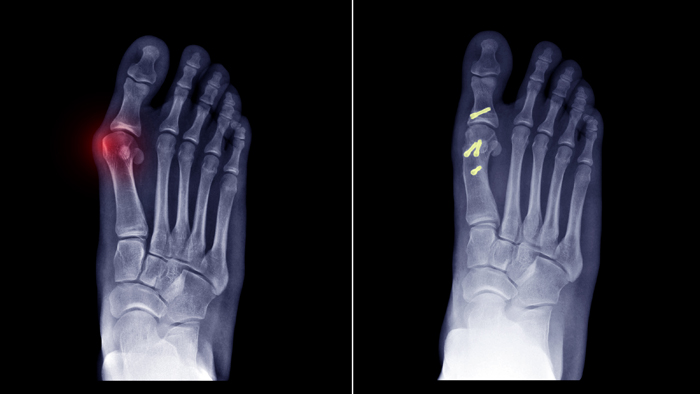Bone Deformity Correction Surgery in Chembur, Mumbai
Orthopedic surgeons utilize arthroscopy to look into a joint to detect and treat problems. A tiny cut is made in the patient’s skin, and a small lens and lighting system are inserted to lighten and enhance the joint structure. Fiber optics convey light from the end of the arthroscope placed into the common to the other end of the arthroscope.
The best ortho doctor near me examines the inside of the joint through this tiny incision instead of the bigger incision required for open surgery by connecting the arthroscope to a compact camera.

About Arthroscopy
The following procedures are done with arthroscopy or a mix of arthroscopic and open surgery:
- Repair of the rotator cuff
- Torn meniscus (knee or shoulder) repair or resection
- ACL repair in the knee
- The synovium is removed from the knee, shoulder, elbow, wrist, or ankle.
- Wrist carpal tunnel release
- Ligament repair
- In the knee, shoulder, elbow, wrist, or ankle, loose bone or cartilage is removed.
Virtually all joints may be examined using an arthroscope. The most typical application is to examine six joints - the ankle, knee, hip, elbow, shoulder, and wrist. Other joints might be treated in the future as fiberoptic technology improves and orthopedic surgeons develop new procedures.
Who Qualifies for Arthroscopy?
Arthroscopic surgery can be used to diagnose and treat a variety of knee ailments, including the following:
- Tears in either the anterior or posterior cruciate ligaments
- Tearing of the meniscus
- Patella that isn't in the proper place
- Loose fragments of torn cartilage in the joint
- Knee bone fractures
- Synovium swelling (the lining in the joint)
Why Is Arthroscopy Conducted
Arthroscopic surgery is a procedure that examines the body's joints to detect the origin or amount of joint injury. If doctors cannot identify the reason for the joint problem, surgery is used.
Different Types of Arthroscopy
- Arthroscopy of the knee
- Arthroscopy of the shoulder
- Elbow arthroscopy
- Wrist arthroscopy
- Arthroscopy of the ankle
- Arthroscopy of the hip
Benefits of Arthroscopic Surgery
Arthroscopy is a procedure involving the diagnosis and repair of a joint. First, a tiny incision is created in the patient's skin for arthroscopic inspection, through which pencil-sized equipment with a small lens and illumination system (arthroscope) are passed.
Arthroscopy is beneficial in diagnosing and treating the following conditions:
- Inflammation The knee, shoulder, elbow, wrist, or knee lining is inflamed with synovitis.
- Chronic and acute injuries: Carpal tunnel syndrome, cartilage tears, tendon rips, and other damage include additional shoulder, knee, and wrist joints.
- Osteoarthritis is arthritis in that cartilage wears out in the joints.
- Remove joints that are obstructed because of the loose mass of the bone or cartilage.
Arthroscopy surgery can be done under general, spinal, or local anesthesia, depending on the circumstance. To insert the arthroscope, a buttonhole-sized incision is used. Specially developed tools will be put through other incisions. The arthroscope is withdrawn, and wounds are closed when the treatment is done. For a quicker recovery, you may be given instructions to care for your incision, what activities to avoid, and what exercises to do.
You can request an appointment at Apollo Spectra Hospitals, Chembur, Mumbai.
Call 1860 500 2244 to book an appointment.
Complications of Arthroscopy
Infection, phlebitis (blood clotting in veins), severe swelling, bleeding, blood vessel or nerve injury, and tool fracture are only a few of the potential problems after an arthroscopy.
The arthroscope is usually used to look at six different joints. They include the knee, shoulder, hip, knee-elbow, and wrist.
Although arthroscopy problems are uncommon, they do happen. Vein clots, infection, severe edema, bleeding, blood vessel or nerve injury, and muscle injury are examples.
Compared to traditional open surgery, arthroscopic surgery offers a faster recovery and minor discomfort since less muscle and tissue is disrupted during the treatment. Most patients are treated as outpatient patients, and within a few hours after their procedure, they can return home.
If you're given general anesthesia, you'll fall asleep and have no sensations. If a localized anesthetic is used, your arm or leg will be numb for many hours. You will be completely unaffected during the Procedure. Following your arthroscopic treatment, you should expect mild soreness and pain. You will be prescribed pain medication and advised to apply ice to your joint by your orthopedic doctor. As a result of this, pain and edema are minimized. During the healing process, make sure your bandages are clean and dry.
Symptoms
Our Top Specialities
NOTICE BOARD
CONTACT US
CONTACT US
 Book Appointment
Book Appointment


.svg)
.svg)
.svg)
.svg)








